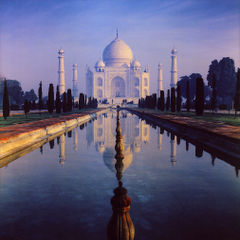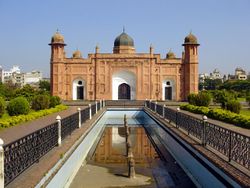Mughal architecture
Mughal architecture, an amalgam of Islamic, Persian[1][2] and Indian architecture, is the distinctive style developed by the Mughals in the 16th and 17th centuries in what is now India, Pakistan, and Bangladesh.
Some of the first and most characteristic examples that remain of early Mughal architecture were built in the short reign (1540–1545) of emperor Sher Shah Suri, who was not a Mughal; they include a mosque known as the Qila i Kuhna (1541) near Delhi, and the military architecture of the Old Fort in Delhi, the Lalbagh Fort in Bangladesh , and Rohtas Fort, near Jhelum in present-day Pakistan. His mausoleum, octagonal in plan and set upon a plinth in the middle of an artificial lake, is in Sasaram, and was completed by his son and successor Islam Shah Suri (1545AD-1553AD).
Contents |
Akbar
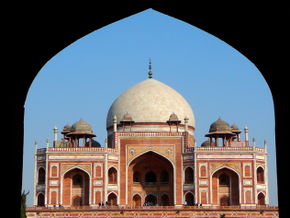
The emperor Akbar (1556–1605) built largely, and the style developed vigorously during his reign. As in the Gujarat and other styles, there is a combination of Muslim and Hindu features in his works. Akbar constructed the royal city of Fatehpur Sikri, located 26 miles (42 km) west of Agra, in the late 1500s. The numerous structures at Fatehpur Sikri best illustrate the style of his works, and the great mosque there is scarcely matched in elegance and architectural effect; the south gateway which is known as Buland Darwaza, from its size and structure excels any similar entrance in India. The Mughals built impressive tombs, which include the fine tomb of Akbar's father Humayun, and Akbar's tomb at Sikandra, near Agra, which is a unique structure of the kind and of great merit.
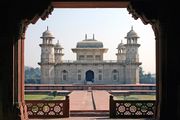
Under Jahangir (1605–1627) the Hindu features vanished from the style; his great mosque at Lahore is in the Persian style, covered with enamelled tiles. At Agra, the tomb of Itmad-ud-Daula completed in 1628, built entirely of white marble and covered wholly by pietra dura mosaic, is one of the most splendid examples of that class of ornamentation anywhere to be found. Jahangir also built the Shalimar Gardens and its accompanying pavilions on the shore of Dal Lake in Kashmir. He also built a monument to his pet deer, Hiran Minar in Sheikhupura, Pakistan and due to his great love for his wife, after his death she went on to build his mausoleum in Lahore.
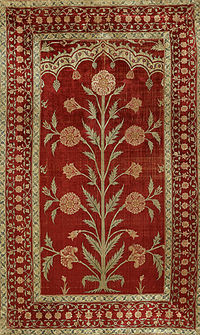
Shah Jahan
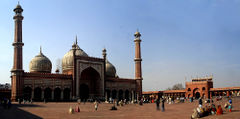
The force and originality of the style gave way under Shah Jahan (1627–1658) to a delicate elegance and refinement of detail, illustrated in the magnificent palaces erected in his reign at Agra and Delhi, the latter one the most exquisitely beautiful in India. The most splendid of the Mogul tombs, and the most renowned building in India, is the Taj Mahal at Agra, the tomb of Mumtaz Mahal, the wife of Shah Jahan.The Moti Masjid (Pearl Mosque) in the Agra Fort and The Jama Masjid at Delhi are imposing buildings, and their position and architecture have been carefully considered so as to produce a pleasing effect and feeling of spacious elegance and well-balanced proportion of parts. In his works Shah Jahan presents himself as the most magnificent builder of Indian sovereigns. He also built the mausoleum and sections of the huge Lahore Fort that include the impressive Moti Masjid, Sheesh Mahal, and Naulakha pavilion which are all enclosed in the fort. He also built a mosque after himself in Thatta called Shahjahan Mosque. Another mosque was built during his tenure in Lahore called Wazir Khan Mosque, by Shaikh Ilm-ud-din Ansari who was the court physician to the emperor.
Taj Mahal
The Taj Mahal, the "teardrop on the cheek of eternity" (Rabindranath Tagore), was completed in 1648 by the emperor Shah Jahan in memory of his wife Mumtaz Mahal. Its longest plane of symmetry runs through the entire complex except for the sarcophagus of Shah Jahan, which is placed off center in the crypt room below the main floor. This symmetry extended to the building of an entire mirror mosque in red sandstone, to complement the Mecca-facing mosque place to the west of the main structure.
The Taj Mahal (1630–1648) in Agra, India and the Shalimar Garden (1641–1642) in Lahore, Pakistan, are two sites which are on the world heritage list of UNESCO. One can see the architectural similarities and the love for water that the Mughals expressed in many of their buildings.
The Taj is considered to be one of the most beautiful monuments of love and is one of the Seven Wonders of the World, when it comes to tourism.
Aurangzeb and later Mughal architecture
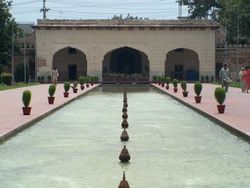
In Aurangzeb's reign (1658–1707) squared stone and marble gave way to brick or rubble with stucco ornament. Srirangapatna and Lucknow have examples of later Indo-Muslim architecture. He also added his mark to the Lahore Fort. He also built one of the thirteen gates, and it was later named after him, Alamgir. The most impressive building of Aurangzeb's reign, is the Badshahi Mosque which was constructed in 1674 under the supervision of Fida'i Koka. This mosque is adjacent to the Lahore Fort. Badshahi Mosque is the last in the series of great congregational mosques in red sandstone and is closely modeled on the one Shah Jahan built at Shahjahanabad. The red sandstone of the walls contrasts with the white marble of the domes and the subtle intarsia decoration. The materials depart from the local tradition of tile revetment that is seen in the Wazir Khan Mosque. According to Blair and Bloom, the cusped arches and arabesque floral patterns inlaid in white marble give the building, despite its vast proportions, a lighter appearance than its prototype.Additional monuments from this period are associated with women from Aurangzeb's imperial family. The construction of the elegant Zinat al-Masjid in Daryaganij was overseen by Aurangzeb's second daughter Zinat al-Nisa. The delicate brick and plaster mausoleum in the Roshan-Ara-Bagh in Sabzimandi was for Aurangzeb's sister Roshan-Ara who died in 1671. Unfortunately, the tomb of Roshanara Begum and the beautiful garden surrounding it were neglected for a long time and are now in an advanced state of decay.Bibi Ka Maqbara a mausoleum was built by Prince Azam Shah, son of Emperor Aurangzeb, in the late 17th century as a loving tribute to his mother, Dilras Bano Begam in Aurangabad, Maharashtra.The Alamgiri Gate, built in 1673 A.D., is the main entrance to the Lahore Fort in present day Lahore, Pakistan. It was constructed to face west towards the Badshahi Mosque in the days of the Mughal Emperor Aurangzeb. The monumental gateway is an imposing vestibule flanked by two semi-circular bastions that have boldly fluted shafts and lotus petalled bases and are crowned with domed pavilions.
Another mervellous construction of Mughal era is the Lalbagh Fort (also known as "Fort Aurangabad"), a Mughal palace fortress at the Buriganga River in the southwestern part of Dhaka, Bangladesh, Construction of of which started in 1678 during the reign of Aurangzeb.[3]
Mughal gardens
Mughal gardens are a group of gardens built by the Mughals in the Islamic style of architecture. This style was influenced by Persian gardens and Timurid gardens. Significant use of rectilinear layouts are made within the walled enclosures. Some of the typical features include pools, fountains and canals inside the gardens. The famous gardens are the Char Bagh gardens at Taj Mahal, Shalimar Gardens of Lahore, Delhi and Kashmir as well as Pinjore Garden in Haryana.
Characteristic elements of Mughal architecture
- Jharokha
- Chhatri
- Chhajja
- Jali
- Charbagh
- symmetry
See also
- Pakistani architecture
- Mughal gardens
- Jharokha
- Ebba Koch
- Safdarjung's Tomb
References
- ↑ History of the Taj Mahal Agra, Retrieved on: 20 January 2009.
- ↑ Anon. "The Taj mahal". Islamic architecture. Islamic Arts and Architecture Organization. http://www.islamicart.com/library/empires/india/taj_mahal.html. Retrieved 22 may 2009.
- ↑ Taifoor, S.M. Glimpses of Old Dacca. Dhaka, 1956.
 This article incorporates text from a publication now in the public domain: Chisholm, Hugh, ed (1911). Encyclopædia Britannica (Eleventh ed.). Cambridge University Press.
This article incorporates text from a publication now in the public domain: Chisholm, Hugh, ed (1911). Encyclopædia Britannica (Eleventh ed.). Cambridge University Press.- Keay, John (2000). India: a History. Grove Press, New York.
External links
- Mughal Gardens (Gallery of the Smithsonian Institution)
- Jali/Jharokha/Jala/Jalaka (From Mughal Architecture, Agra, India)
|
|||||||||||
|
||||||||||||||
